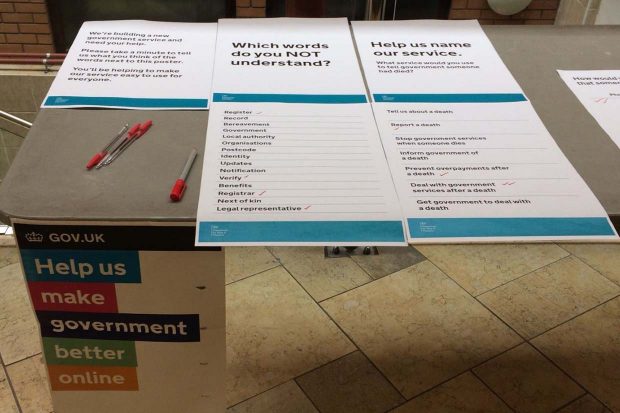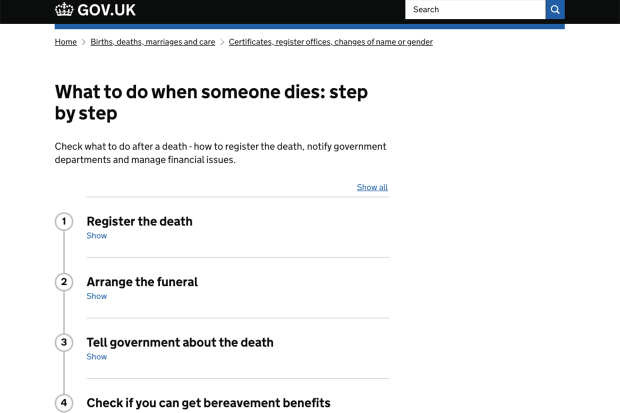
I’m a content designer for DWP based in Newcastle. I’ve been working with dedicated, compassionate teams to design services that help the people left behind after the loss of someone close.
We’ve done lots of research with bereaved people. This has helped us to understand what sort of information people need during what could be the hardest moments of their lives. As a content designer, it’s my job to figure out how best to give that information.
I’ve spent the last couple of years thinking about the words we use when we talk about death. Here’s what I’ve learnt and how it’s shaping the content we design.
We need to use clear and sensitive language
Death is something everyone will need to think about, but that doesn’t mean everyone is ready to do so when it happens. It’s tempting to use words that will soften the pain, to avoid the words that might hurt the most. I’ve done it myself, in the first paragraph of this blog.
I said ‘after the loss of someone close’. I thought it a kinder way of saying ‘when someone dies’. Yet some people could easily misunderstand this: ‘loss’ is less direct than ‘dies’.
We found that while some people felt uncomfortable seeing words like ‘died’ or ‘funeral’, more people needed us to be upfront with our language. When grief overwhelms, thinking about day-to-day tasks becomes very difficult.

Lots of people had very little idea of what needed to be done in the days after a death. Do you find a funeral director first or sort out the will? Cancel bank accounts and benefits or deal with the estate?
When someone has to deal with the government after a death, they often have to understand new terms like ‘deal with the estate’, ‘next of kin’ and even ‘government’. They have to define things they might not have thought about, like their ‘relationship to the deceased’ and ‘dependent children’.
There’s no room for doubt or misunderstanding. That means the words we use must get straight to the point. By trying to be kind, we often use more words when we should be helping people to understand what they need to do as quickly and simply as possible.
We need to give just enough detail
People need to know what information they’ll be asked for before using a service. We found they also need to know exactly what will happen as a result of using a service, so they can keep track of what they need to do without having to chase for updates. But we need to spell things out clearly and carefully. If we give too much detail, then we risk it turning into background noise.
We know that lots of people coping with a death will ask a close friend or family member to take care of some things. Helpers need time to gather information so that they can do what they need to. If they get part-way through applying for something only to have to pause to find a letter, chances are they’ll get tied up doing something else.
We need to help people understand what they need to do by:
- only telling them what they need to know, when they need to know it – for example, what happens after applying for Bereavement Support Payment
- explaining why we need to ask certain questions
- breaking information into easily manageable chunks
We need to be consistent in how we talk about death
If we’re using different words to say the same thing, we risk confusing people. So, we’ve added an entry on death to our style guide to make sure we’re being consistent:
death
Be direct wherever possible. Say “death” instead of “loss” and “died” instead of “passed away”.
Research shows that people dealing with a death appreciate clear, succinct communication at what is often a confusing and stressful time. Euphemisms are harder for people to understand, especially for those who do not speak English as a first language.
| Use | Do not use |
| death |
|
| died |
|
Research shows that brief, plain language is more helpful than content added to make something sound more sympathetic. People would rather quickly understand what they need to do than read through lengthy condolences.
Do not assume all people are grieving; some may not be. If research shows some users would find sympathetic content helpful, be careful not to suggest how they should be feeling in your writing. They might not be experiencing a sense of loss and it might not be a difficult time for them.
| Avoid |
| Please accept our sympathies for your loss.
We are sorry to contact you at this difficult time. |
When we were doing our research, one person told us: "When you’re grieving, everything shuts down." It’s a common theme, and why we try to understand what our users are going through. It’s always important to give people only what they need to know, not what we want them to know – even more so when they’re dealing with a death.
Like this blog? Why not subscribe for more blogs like this? Sign up for email updates whenever new content is posted!

9 comments
Comment by Annette Cuthbertson posted on
Having just supported my husband and mother-in-law when my father-in-law died last year, this really resonated.
It is a minefield to get through all the paperwork, understand the gov.uk guidance. At the same time you have your normal day to day activities, financial paperwork and other family crises to handle so anything which can ease the burden has got to be good.
Comment by Simon Bramble posted on
Hi Annette. Thanks so much for taking the time to read and comment on this. What you mentioned is so important: when someone dies, people often have so much to think about and sort out. The least we can do is make information easier to understand. It's through speaking to people who have been through these experiences that we can make things better. We're hugely grateful to them for giving up their time.
Comment by Kate Wilhelm posted on
This is so good! I’m curious about the final direction not to offer sympathy since people may or may not be grieving or having a difficult time. I’m wondering what effects you saw in your research on people who did not feel a sense of loss when they read content like that. On the flip side, how did people who did feel a sense of loss respond to content that lacked sympathy or emotional awareness?
Comment by Simon Bramble posted on
Hi Kate, thanks for your questions! Just to be clear, we didn’t find that not offering sympathy should be a standard approach. Only that, if we find that research suggests it would be helpful, we should be careful how we frame that sympathy.
When people weren’t feeling a sense of loss, we got some pretty strong reactions to things like ‘Sorry for your loss’. It could be very upsetting for some people in that situation. On the other hand, they appreciated brief content that got straight to whatever it was they needed to know or do.
For people who did feel a sense of loss, we found some people commented on the lack of a ‘Sorry…’ message, but overall, they appreciated clear content that gave them the information they needed as quickly as possible.
I think what we learned is that there’s a difference between sympathy and emotional awareness. We could demonstrate the latter by being aware of the situation people were in, and in a lot of cases, we found that cutting back on content and making it easier to consume proved very helpful. We also found that we could round off some of the harsher edges – for example, instead of saying ’Send now’ or similar, language like ‘When you’re ready…’ resonated more with many people.
Comment by J Richards posted on
Yes, could please elaborate on both of Kate's questions?
Shortly I'll be researching a group of people dealing with bereavement. How did you conduct your research? Anything you'd do differently?
Comment by Simon Bramble posted on
Hi there. Thanks for reading this. You might find this blog post from one of the user researchers I worked with helpful:
https://dwpdigital.blog.gov.uk/2019/05/23/how-we-approach-research-with-vulnerable-users/
Comment by C Nichols posted on
A really interesting read. I work in the hospice sector and would be interested in seeing some of your research, if you'd be willing to share it?
Comment by Simon Bramble posted on
Hello. Thank you for taking the time to read this. Unfortunately, we cannot share research documents – this would go against the consent we asked our participants for. However, I can talk you through some of the themes we found, if that would help?
Comment by Ian Price posted on
A really excellent and well thought through blog. I used to manage a 'death notification' team in a previous job and am very aware of the balance required between using plain and simple language and being aware of when someone needs more support. We were always focussed on keeping it simple and easy to follow, and ensuring that we listened not only to what our customers were saying but also to how they were saying it.
Great to see the level of thought that goes into this at DWP, all of the points noted in the blog really resonated with me.